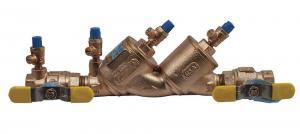 A double check valve is a backflow prevention device designed to protect water supplies from contamination. It consists of two autonomously acting, spring-loaded check valves. It includes shutoff valves at each end of the piece and very small ball valves. A double check valve is quite useful against backpressure backflow and back-siphonage but should be used to separate only non-health hazards. For higher hazard conditions you should use a reduced pressure zone valve assembly instead. Double check valves are used primarily in fire prevention and landscaping water systems.
A double check valve is a backflow prevention device designed to protect water supplies from contamination. It consists of two autonomously acting, spring-loaded check valves. It includes shutoff valves at each end of the piece and very small ball valves. A double check valve is quite useful against backpressure backflow and back-siphonage but should be used to separate only non-health hazards. For higher hazard conditions you should use a reduced pressure zone valve assembly instead. Double check valves are used primarily in fire prevention and landscaping water systems.
The double check valve was initially created about seventy years ago for the fire department. Any time the pressure on the property side exceeds the pressure on the city side, the two redundant check valves close preventing the reverse water flow. When a flow stop happens, the valve shuts; it is then that the relief valve releases and dumps the water in between the pipes.
Having two check valves instead of one is useful because one check valve will still act, even if the other is stuck open. Also, the shutting of one valve reduces the pressure differential across the other, allowing a more dependable seal and circumventing any sort of leak. It is critically important to regularly check and test these valves to make sure they are functioning properly.